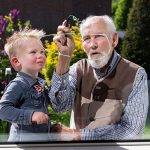Out of the loneliness:
The social care in nursing homes often has the reputation to animate residents as in a club vacation. Sitting dance, ball games or a round of ludo do not look like pleasure at first sight. The activation of seniors is a highly complex matter. If it looks „playful“, caregivers are doing a good job. Petra Seewald from the Wohngemeinschaft für Senioren (WGfS) in Filderstadt near Stuttgart explains what is important when activating and gives tips for colleagues:
1.) Slowly approach
To activate seniors, social care workers need to know the current condition and biography of the resident. Who sits opposite me, what can we do, how do I pick up the man or the woman – are the first aspects of approaching humans.
2.) Try it for free
This is followed by trial and error. In the individual care, which is usually offered in the mornings, because there are people there awake and fitter, social carers test what activations go. „It’s important to find out what the senior likes to do,“ says Seewald. Mood and energy should be casual. Not like at school, where tasks have to be done. The feeling of being needed, fun and success are indicators.
3.) Invite instead of asking
So caregivers can invite residents to say, „I’m taking care of the flowers today, are you trying to help me with that?“ Another good approach is to invite the seniors to join them. Something like this: „Today is trainee is here, could you show him how to bake a cake?“
4.) Know preferences
The chances increase when the activation aims at the biography of the resident. „If an elderly woman used to care for roses in the garden, she will probably help to take care of the flowers in the living area,“ explains Seewald, who also offers men’s family tables in Filderstadt, where it is „a real treat“. As on Sundays after the service in the tavern. „We invite the sons of the residents,“ says the expert.
5.) Exercise memory
Whether it’s flower care, baking a cake or a regular’s table – all activating actions serve to train the memory of the inhabitants. This goes, inter alia, memory work. This is how the men tell when they stand at the bar from the old days. For example, funny binoculars or card games or the angry wife who sat at home with the roast on Sundays and waited for her husband. While he drank beer instead in the tavern.

6.) Basal stimulation
When senior women talk about helping out in the kitchen as young girls on the farm, social carers can specifically ask if they remember the smell of freshly baked bread. Or what herbs and salts they have added to the dough. If this happens while something is also being baked in the nursing home , more senses will be addressed. „The memory work is supported by the basal stimulation,“ clarifies Seewald.
7.) Moderate processes
The social counselor of WGfS also points out that communication should never be crowded or regulated. Some residents can not pay anymore. Who dices with them, such as the ludo game, should moderate the litters: „Aha, now you’ve diced a four, Ms. Maier.“
8.) 1×1 competition
„For mentally fit seniors, playing 1×1 is a fantastic exercise,“ says Seewald. Older people had to learn computational skills in elementary school and were asked by the teacher. To train this „sport“ with grandchildren, pupils, interns in the competition, is well received. As fired from the gun, many seniors can tell the results by heart. „There are young people out there“ laughs Seewald. And the applause and the praise touch the inhabitants.
9.) Organize excursions
Seewald recommends starting as many trips with seniors as possible in the light of the interaction. In the railway museum, the folk festival, the knight’s castle, in the nursery and services, the residential community would chauffeur residents. It is important to stage individual actions. „If we visit an ice cream parlor with about 20 residents, we’ll go to the ice cream counter with each one individually,“ reports Seewald. In addition to selection and order, it is important that the seniors actively pay their own ice cream. This pleases the elderly and is better than sitting passively by the table and waiting for waiters to turn off the ice cream cups.
10.) Create happy moments
Ultimately, it is about creating happiness, Seewald. Even if the visit to Gelateria is forgotten within minutes, the expert has observed that the moment of payment increases the memory of childhood. „People still remember how they bought their first ice cream as little children. We bring back those moments. „
11.) Cushioning deficits
Activation is valuable if deficits of the inhabitants are lovingly caught. That could be a tango teacher dancing with a senior citizen and her rollator. Or a therapy dog waiting for a caregiver at the bedside. Also meditative craniosacral treatments, pressure massages or a special strength training would help the residents to perceive their own body feeling again and better.


